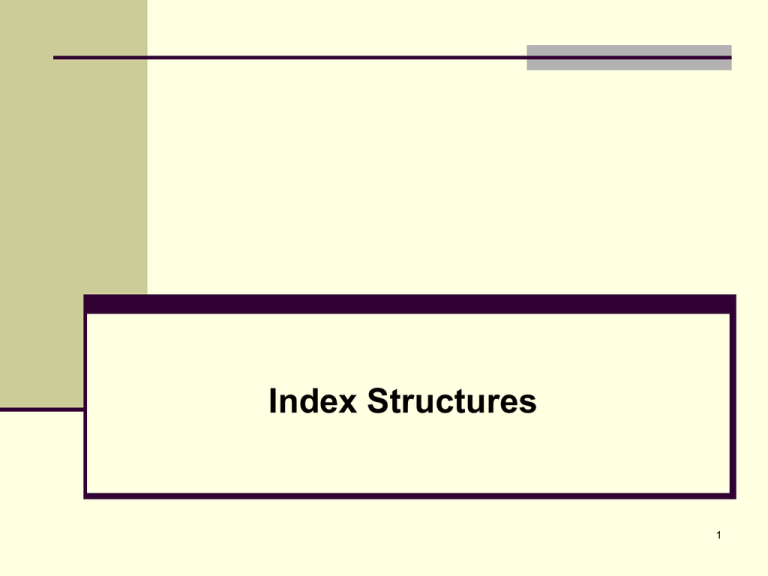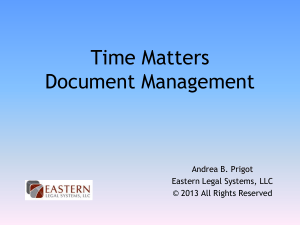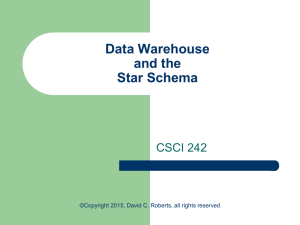Secondary Index
advertisement

Index Structures 1 Chapter : Objectives Types of Single-level Ordered Indexes Primary Indexes Clustering Indexes Secondary Indexes Multilevel Indexes Dynamic Multilevel Indexes Using B-Trees and B+-Trees Indexes on Multiple Keys 2 Indexes as Access Paths A single-level index is an auxiliary file that makes it more efficient to search for a record in the data file. The index is usually specified on one field of the file (although it could be specified on several fields) One form of an index is a file of entries <field value, pointer to record>, which is ordered by field value The index is called an access path on the field. 4 Indexes as Access Paths (contd.) The index file usually occupies considerably less disk blocks than the data file because its entries are much smaller A binary search on the index yields a pointer to the file record Indexes can also be characterized as dense or sparse. A dense index has an index entry for every search key value (and hence every record) in the data file. A sparse (or nondense) index, on the other hand, has index entries for only some of the search values 5 Indexes as Access Paths (contd.) Example: Given the following data file: EMPLOYEE(NAME, SSN, ADDRESS, JOB, SAL, ... ) Suppose that: record size R=150 bytes block size B=512 bytes r=30000 records Then, we get: blocking factor Bfr= B div R= 512 div 150= 3 records/block number of file blocks b= (r/Bfr)= (30000/3)= 10000 blocks For an index on the SSN field, assume the field size VSSN=9 bytes, assume the record pointer size PR=7 bytes. Then: index entry size RI=(VSSN+ PR)=(9+7)=16 bytes index blocking factor BfrI= B div RI= 512 div 16= 32 entries/block number of index blocks b= (r/ BfrI)= (30000/32)= 938 blocks binary search needs log2bI= log2938= 10 block accesses This is compared to an average linear search cost of: (b/2)= 30000/2= 15000 block accesses If the file records are ordered, the binary search cost would be: log2b= log230000= 15 block accesses 6 Types of Single-Level Indexes Primary Index Defined on an ordered data file The data file is ordered on a key field Includes one index entry for each block in the data file; the index entry has the key field value for the first record in the block, which is called the block anchor A similar scheme can use the last record in a block. A primary index is a nondense (sparse) index, since it includes an entry for each disk block of the data file and the keys of its anchor record rather than for every search value. 7 Primary index on the ordering key field of the file shown in Figure . 8 Types of Single-Level Indexes Clustering Index Defined on an ordered data file The data file is ordered on a non-key field unlike primary index, which requires that the ordering field of the data file have a distinct value for each record. Includes one index entry for each distinct value of the field; the index entry points to the first data block that contains records with that field value. It is another example of nondense index where Insertion and Deletion is relatively straightforward with a clustering index. 9 A clustering index on the DEPTNUMBER ordering nonkey field of an EMPLOYEE file. 10 Clustering index with a separate block cluster for each group of records that share the same value for the clustering field. 11 Types of Single-Level Indexes Secondary Index A secondary index provides a secondary means of accessing a file for which some primary access already exists. The secondary index may be on a field which is a candidate key and has a unique value in every record, or a nonkey with duplicate values. The index is an ordered file with two fields. The first field is of the same data type as some nonordering field of the data file that is an indexing field. The second field is either a block pointer or a record pointer. There can be many secondary indexes (and hence, indexing fields) for the same file. Includes one entry for each record in the data file; hence, it is a dense index 12 A dense secondary index (with block pointers) on a nonordering key field of a file. 13 A secondary index (with recored pointers) on a nonkey field implemented using one level of indirection so that index entries are of fixed length and have unique field values. 14 15 Multi-Level Indexes Because a single-level index is an ordered file, we can create a primary index to the index itself ; in this case, the original index file is called the first-level index and the index to the index is called the second-level index. We can repeat the process, creating a third, fourth, ..., top level until all entries of the top level fit in one disk block A multi-level index can be created for any type of first-level index (primary, secondary, clustering) as long as the first-level index consists of more than one disk block 16 A two-level primary index resembling ISAM (Indexed Sequential Access Method) organization. 17 Multi-Level Indexes Such a multi-level index is a form of search tree ; however, insertion and deletion of new index entries is a severe problem because every level of the index is an ordered file. 18 FIGURE 4.8 A node in a search tree with pointers to subtrees below it. 19 FIGURE 4.9 A search tree of order p = 3. 20 Dynamic Multilevel Indexes Using BTrees and B+-Trees Because of the insertion and deletion problem, most multi-level indexes use B-tree or B+-tree data structures, which leave space in each tree node (disk block) to allow for new index entries These data structures are variations of search trees that allow efficient insertion and deletion of new search values. In B-Tree and B+-Tree data structures, each node corresponds to a disk block Each node is kept between half-full and completely full 21 Dynamic Multilevel Indexes Using BTrees and B+-Trees (contd.) An insertion into a node that is not full is quite efficient; if a node is full the insertion causes a split into two nodes Splitting may propagate to other tree levels A deletion is quite efficient if a node does not become less than half full If a deletion causes a node to become less than half full, it must be merged with neighboring nodes 22 Difference between B-tree and B+-tree In a B-tree, pointers to data records exist at all levels of the tree In a B+-tree, all pointers to data records exists at the leaf-level nodes A B+-tree can have less levels (or higher capacity of search values) than the corresponding B-tree 23 FIGURE 4.10 B-tree structures. (a) A node in a B-tree with q – 1 search values. (b) A B-tree of order p = 3. The values were inserted in the order 8, 5, 1, 7, 3, 12, 9, 6. 24 FIGURE 4.11 The nodes of a B+-tree. (a) Internal node of a B+-tree with q –1 search values. (b) Leaf node of a B+-tree with q – 1 search values and q – 1 data pointers. 25 Choose file organizations and indexes Determine optimal file organizations to store the base tables, and the indexes required to achieve acceptable performance. Consists of the following steps: Step 1 Analyze transactions Step 2 Choose file organizations Step 3 Choose indexes 26 Analyze transactions To understand functionality of the transactions and to analyze the important ones. Identify performance criteria, such as: transactions that run frequently and will have a significant impact on performance; transactions that are critical to the business; times during the day/week when there will be a high demand made on the database (called the peak load). 27 Analyze transactions Use this information to identify the parts of the database that may cause performance problems. Often not possible to analyze all expected transactions, so investigate most ‘important’ ones. 28 Choose file organizations To determine an efficient file organization for each base table. File organizations include Heap, Hash, Indexed Sequential Access Method (ISAM), B+-Tree, and Clusters. Some DBMSs (particularly PC-based DBMS) have fixed file organization that you cannot alter. 29 Choose indexes Determine whether adding indexes improve the performance of the system. will One approach is to keep records unordered and create as many secondary indexes as necessary. 30 Choose indexes Or could order records in table by specifying a primary or clustering index. In this case, choose the column for ordering or clustering the records as: column that is used most often for join operations - this makes join operation more efficient, or column that is used most often to access the records in a table in order of that column. 31 Choose indexes If ordering column chosen is key of table, index will be a primary index; otherwise, index will be a clustering index. Each table can only have either a primary index or a clustering index. Secondary indexes provide additional keys for a base table that can be used to retrieve data more efficiently. 32 Choose indexes – Guidelines for choosing ‘wish-list’ (1) Do not index small tables. (2) Add secondary index to any column that is heavily used as a secondary key. (3) Add secondary index to a FK if it is frequently accessed. (4) Add secondary index on columns that are involved in: selection or join criteria; ORDER BY; GROUP BY; and other operations involving sorting (such as UNION or DISTINCT). 33 Choose indexes – Guidelines for choosing ‘wish-list’ (5) Add secondary index on columns involved in built-in functions. (6) Add secondary index on columns that could result in an index-only plan. (7) Avoid indexing an column or table that is frequently updated. (8) Avoid indexing an column if the query will retrieve a significant proportion of the records in the table. (9) Avoid indexing columns that consist of long character strings. 34






